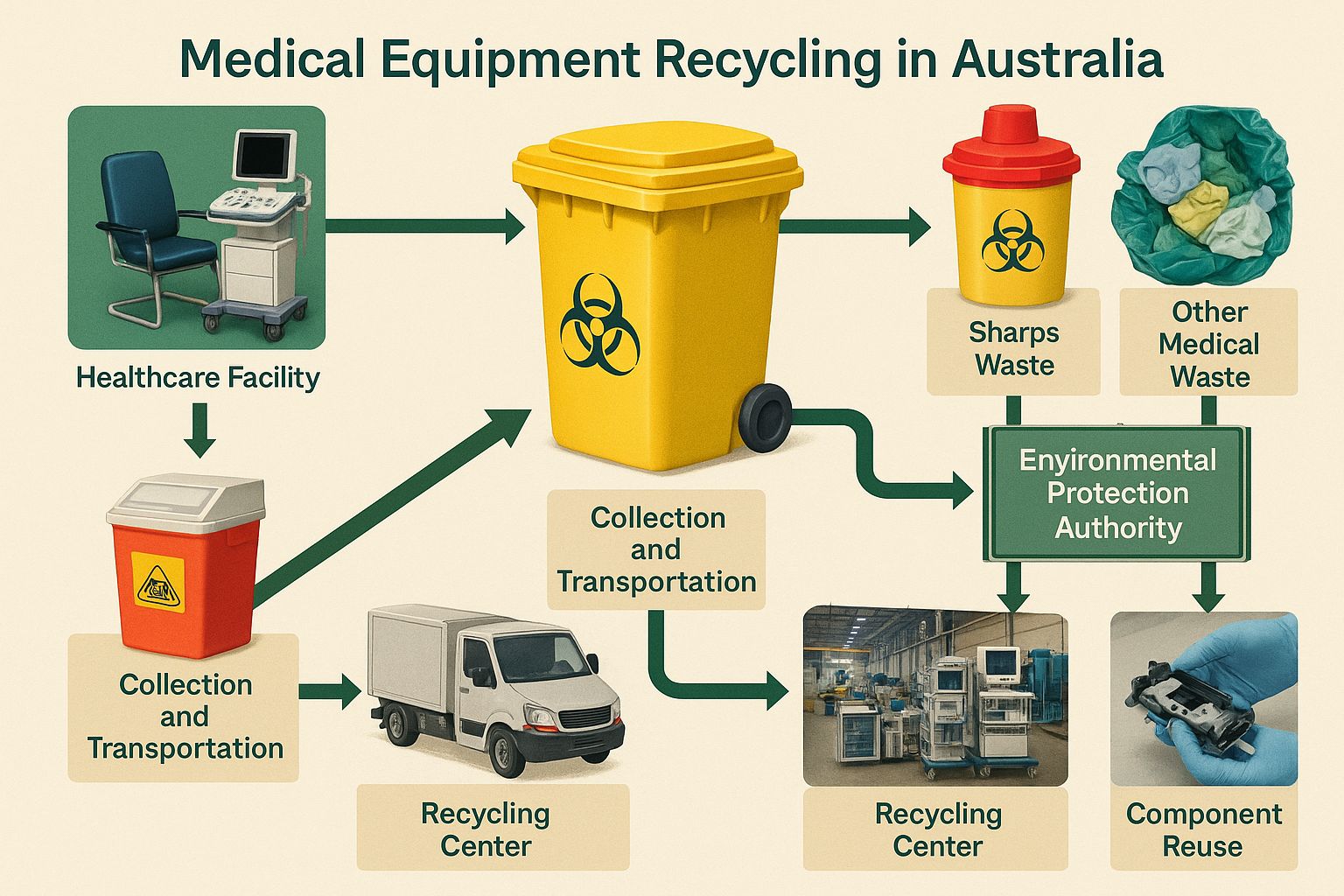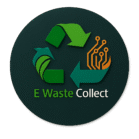The healthcare sector in Australia generates a significant volume of equipment and waste annually. Understanding and complying with medical equipment disposal regulations in Australia is paramount, as failure to do so can lead to serious health and environmental hazards, as well as significant legal repercussions and financial penalties for healthcare facilities and businesses.
This comprehensive 2025 guide will help you navigate the key laws and guidelines for the safe and responsible disposal and medical equipment recycling in Australia. Join us as we explore how to optimize your waste disposal processes and ensure full compliance with the latest legal requirements.

Why Is Proper Medical Equipment Disposal & Recycling Crucial?
Improper disposal of medical equipment can have widespread consequences, affecting not only human health but also the environment and your business's standing. Adhering to medical equipment disposal regulations Australia and prioritizing recycling mitigates these risks:
- Health Risks: Used equipment may be contaminated with pathogens, blood, or bodily fluids. Improper disposal increases the risk of infection transmission to staff, the public, and the environment.
- Physical Injuries: Sharp instruments like needles and scalpels, if not disposed of correctly, can cause cuts and injuries.
- Environmental Contamination: Many medical devices contain heavy metals, non-biodegradable plastics, and hazardous chemicals. Releasing these into landfills or the natural environment can lead to soil, water, and air pollution. Proper medical equipment recycling helps prevent this.
- Legal and Financial Penalties: Australian federal, state, and territory environmental agencies enforce strict medical equipment disposal regulations Australia. Violations can result in hefty fines, license revocation, and damage to your business's reputation.
- Brand Image and Sustainability: Adhering to sustainability principles and responsible waste management, including robust medical equipment recycling programs, enhances your public image and credibility, demonstrating your commitment to social and environmental responsibility.
Key Regulations & Governing Bodies for Medical Equipment Disposal & Recycling in Australia
In Australia, no single federal law specifically governs "medical equipment disposal." Instead, responsibility for medical equipment disposal regulations Australia and recycling efforts is shared among various bodies at the federal, state, and territory levels:
1. Therapeutic Goods Administration (TGA)
The TGA primarily oversees the safety, quality, and performance of medical devices throughout their lifecycle. Their guidelines are foundational to understanding medical equipment disposal regulations Australia.
While the TGA does not directly regulate waste disposal processes, it requires manufacturers and sponsors of medical devices to include information in their "Instructions for Use (IFU)" regarding any necessary warnings or precautions for the safe disposal of the device and associated materials after use.
The TGA's "Essential Principles" also include requirements for the design and manufacture of devices that facilitate their safe disposal and, where appropriate, their potential for medical equipment recycling.
2. State and Territory Environmental Protection Authorities (EPAs)
These authorities are the primary regulators and enforcers of waste management laws, including those for medical waste. Their specific directives are crucial for compliance with medical equipment disposal regulations Australia at a local level, and they also encourage recycling initiatives.
Each state and territory (e.g., EPA Victoria, NSW EPA, Queensland DES) has its own specific laws and guidelines for the classification, collection, transport, storage, and disposal of clinical and other hazardous wastes.
These regulations typically cover licensing requirements for waste treatment facilities, as well as packaging, labeling, and documentation standards, which are critical for effective medical equipment disposal regulations Australia and facilitate appropriate recycling streams.
3. Occupational Health and Safety (OHS) / Work Health and Safety (WHS) Laws
OHS/WHS laws in each state/territory govern the health and safety of workers in the workplace, including when handling medical waste. Understanding these laws is an integral part of adhering to medical equipment disposal regulations Australia and safe handling for recycling processes.
These laws require employers to identify, assess, and control risks associated with medical waste and to ensure adequate training for staff.

Classification of Medical Equipment Waste and Disposal/Recycling Methods
Proper management begins with accurate waste classification, a key aspect of medical equipment disposal regulations Australia and crucial for identifying recycling opportunities. Common categories include:
1. Clinical / Biohazardous Waste
- Includes anything contaminated with blood, bodily fluids, or infectious agents (e.g., soiled dressings, bandages, laboratory specimens).
- Disposal Method: Must be collected in dedicated waste bags (usually yellow) or specified containers and managed by specialized medical waste disposal services (typically through incineration or autoclaving). **Not suitable for recycling.**
2. Sharps Waste
- Includes any device that can puncture the skin (e.g., needles, surgical blades, syringes, broken glass vials).
- Disposal Method: Must be immediately placed in dedicated puncture-resistant "Sharps Containers" after use and collected by specialized services. **Generally not recycled due to contamination and safety risks.**
3. Pharmaceutical Waste
- Includes expired, contaminated, or unused medications (including cytotoxic and cytostatic drugs). Adherence to medical equipment disposal regulations Australia is particularly strict for this category.
- Disposal Method: Highly specialized disposal, subject to separate pharmaceutical and environmental regulations. Typically requires collection by specialized companies. **Not suitable for recycling.**
4. Chemical Waste
- Includes disinfectants, solvents, and other chemical substances used in laboratories or medical processes.
- Disposal Method: Must be disposed of according to Safety Data Sheets (SDS) and local regulations, usually by specialized services. **Not suitable for recycling in most cases.**
5. General / Non-Hazardous Waste
- Includes equipment that has not come into contact with contaminated materials or poses no specific hazard (e.g., clean packaging, some clean plastics, paper).
- Disposal Method: Can be disposed of with general waste or recycled where possible. This category presents the most straightforward opportunities for medical equipment recycling.
6. Electronic and Electrical Equipment (E-Waste)
- Includes old electronic devices such as monitors, infusion pumps, laser machines, etc.
- Disposal Method: These often contain heavy metals and valuable components and should be sent to specialized E-waste recycling centers. This aspect of medical equipment disposal regulations Australia is gaining increasing importance for sustainability and resource recovery. **High potential for medical equipment recycling.**

Practical Guide to Medical Equipment Disposal & Recycling Compliance in Australia
Adhering to medical equipment disposal regulations Australia and implementing effective recycling programs requires a systematic approach and continuous vigilance:
- Internal Policies and Procedures: Develop clear, written policies for medical waste management, covering the classification, collection, storage, disposal, and **recycling** of each waste type. These policies should align with medical equipment disposal regulations Australia.
- Staff Training: All personnel involved in generating or managing medical waste must receive regular, up-to-date training on proper disposal procedures, recycling protocols, the use of Personal Protective Equipment (PPE), and emergency response actions.
- Segregation at Source: Waste must be correctly segregated at its point of generation (e.g., in operating rooms, laboratories, or wards) and placed in appropriate containers, distinguishing between waste for disposal and items for medical equipment recycling.
- Standardized Containers and Packaging: Use color-coded and clearly labeled containers that comply with state/territory standards, especially for materials destined for recycling.
- Secure Storage: Waste and recyclables must be stored in secure, designated, well-ventilated areas, inaccessible to unauthorized persons until collection.
- Contract with Licensed Contractors: For the transportation and disposal of hazardous waste, and for specialized medical equipment recycling, ensure you contract with companies that hold the necessary EPA licenses and have a proven track record of compliance. This is a critical part of medical equipment disposal regulations Australia.
- Documentation and Record-Keeping: Maintain meticulous records of all waste management stages, including quantity, type, and date of disposal/recycling, and the contractor's name. These records are vital for inspections.
- Prioritize Reduction, Reuse, and Recycling:
- Strive to reduce waste generation as much as possible.
- Explore possibilities for reusing equipment (where permissible and fully sterilized).
- Consider **medical equipment recycling** programs for plastics, metals, and E-waste. Some medical equipment, like metal prosthetics or specific surgical instruments, can be sent to precious metal recycling centers after sterilization. This supports the long-term goals of medical equipment disposal regulations Australia.
Updates and Future Challenges in Medical Equipment Disposal & Recycling Regulations Australia
The medical industry and its regulations in Australia are constantly evolving. Increasing awareness of environmental sustainability, the growth of new medical equipment technologies (such as more complex and smart devices), and the need to manage emerging waste streams (like new pharmaceuticals) are ongoing challenges. Healthcare facilities and manufacturers must continuously stay informed about the latest TGA and state/territory EPA guidelines and update their processes accordingly to maintain compliance with medical equipment disposal regulations Australia and advance their medical equipment recycling initiatives.
Conclusion: Building a Sustainable Future for Healthcare Waste
The proper management and disposal of medical equipment in Australia, governed by strict medical equipment disposal regulations Australia, is more than just a legal requirement; it's an ethical and environmental responsibility. By thoroughly understanding these regulations, investing in staff training, and partnering with reputable waste disposal and medical equipment recycling contractors, you can ensure public health, protect the environment, and safeguard your business's reputation. These actions will not only keep you in legal compliance but also contribute to building a more sustainable future for the healthcare industry.
